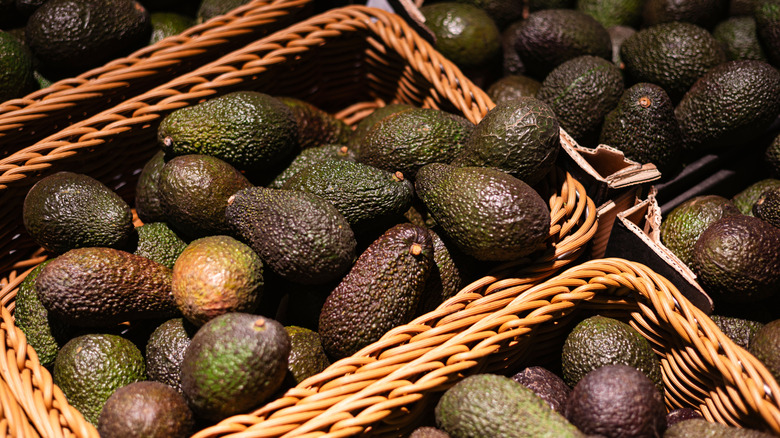Pick The Best Avocados At Your Grocery Store With This Texture Test
When you're doing some weekly grocery shopping and trying to pick the perfect avocado, it tends to be a bit trickier than selecting other fruits. The thick skin conceals the interior; plus, they lack smell, and it's easy to mistake a bruise for ripeness. That's why the best way to determine if the typical Hass avocado is ready is to examine the skin's texture.
Lightly squeezing an avocado to test its flesh and find any dents or bruising is important, but it's not always the best indicator of its ripeness. The skin of a hard, unripened Hass avocado is typically smoother than that of a ripened one, which has prominent bumps. This skin, or exocarp – one of the reasons avocados are a berry – thickens and grows bumpier as the fruit ripens. Farmers love Hass avocados for their thick, textured skins because they're significantly better at protecting the flesh in transit than other, thin-skinned varieties.
The texture of an avocado's exocarp is basically a countdown to full ripeness. While there are plenty of tricks to slow down avocado ripening or ripen them even faster, clocking how long the savory fruit needs to achieve your ideal texture and flavor is your best bet when using them in the kitchen. However, if the texture test isn't enough for you, there are other outward indicators of a Hass avocado's quality.
More feel tests to find the best avocado at the grocery store
Sometimes it's difficult to determine an avocado's ripeness and quality solely based on its bumpy skin. If the texture test fails you, or if you find yourself still questioning your produce, the darkness of an avocado's skin, whether or not you feel gaps between its flesh and skin, and even the area directly underneath the stem are all great factors to consider.
A properly ripe avocado, one ready to eat right when you get home, should have a dark exocarp, not black. A ripe avocado's skin is a bit purplish, closer to an eggplant than a blackberry. If the skin is black, that means it's likely overripe and the flesh has started to decay. You can always pick off that last trace of stem at the top to examine the flesh more closely. If the area looks brown or overly dark, skip the fruit and find another one.
While an avocado with a bit of give is perfect for guacamole, you never want one with noticeable gaps between the exocarp and flesh. Typically, this comes from bruised flesh decaying more rapidly than the rest of the fruit, so you'll have an unsightly, and more importantly, inedible, chunk to discard. Even worse, mold may have crept into the gap, sabotaging the rest of it. Dents, shriveling, lesions, or other odd spots of color or texture are all red flags anytime you're shopping.


